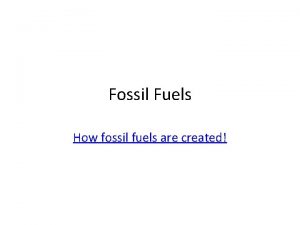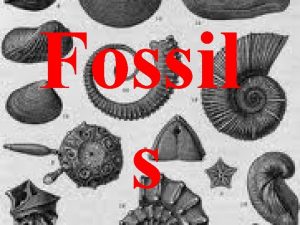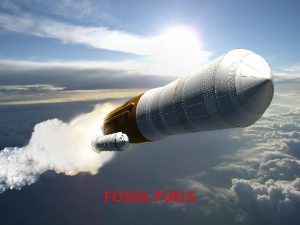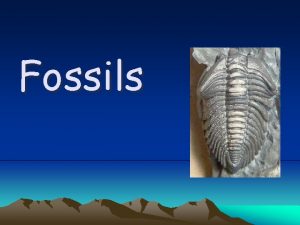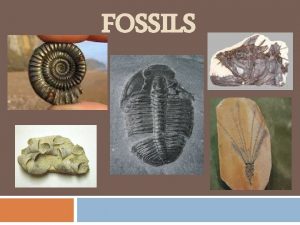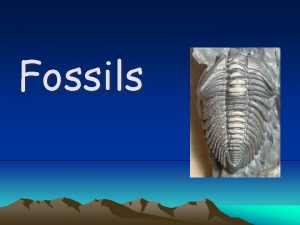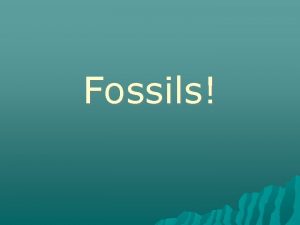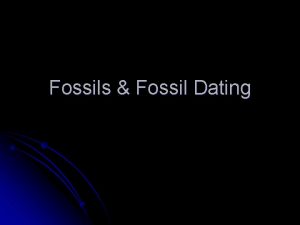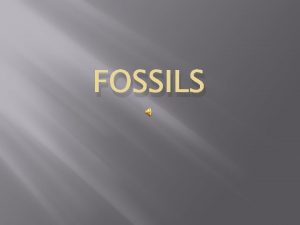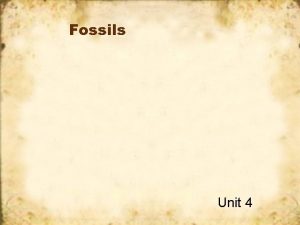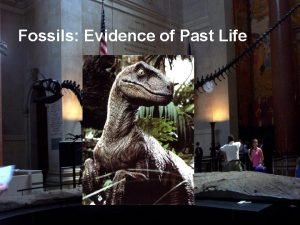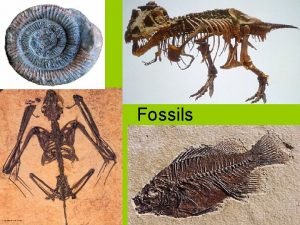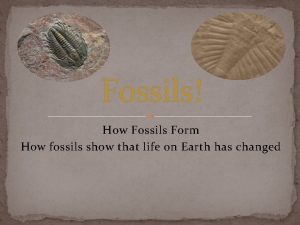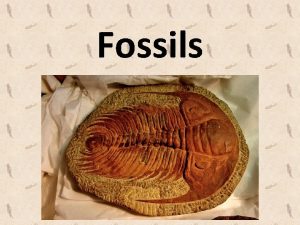Fossils What is a fossil Fossils are the




















- Slides: 20

Fossils

What is a fossil? Fossils are the preserved remains or traces of living things Most fossils form when living things die and are buried by sediments The sediments slowly harden into rock and preserve the shapes of the organisms

What is a paleontologist? A scientist who studies fossils

Sedimentary Rock • The type of rock that is made of hardened sediment • This is also where fossils are usually found

How a fossil forms: 1. Surface Erosion 2. Layers form from Sediments. 3. Sed. Rocks form 4. Fossils form

• • • Shells Bones Teeth Trees tracks

Kinds of Fossils 1. Petrified fossils 2. Molds and casts 3. Carbon films 4. Trace fossils

Petrified Fossils Petrified means “turning into stone” Fossils in which minerals replace all or part of an organism (Example: Petrified wood)

Molds and Casts Mold: a hollow area in sediment in the shape of an organism or part of an organism • Forms when the hard part of the organism such as a shell, is buried in sediment • Later, water carrying dissolved minerals and sediment may seep into the empty space of a mold, creating a cast. Cast: a copy of the shape of an organism

Carbon Films Another type of fossil is a carbon film, which is an extremely thin coating of carbon on rock. This process can preserve delicate parts of insects, flowers or plant leaves.

Trace Fossils This type of fossil provides evidence of the activities of ancient organisms Fossilized foot print Animal activities, diet, where it hunts, and how it obtained food.

Preserved Remains • Tar • Ice • Amber

Tar Sticky oil that seeps from Earth’s surface

Amber A hardened resin, or sap, of evergreen trees 1. Preserved 2. Dies, covers, destruction, body

Freezing Another way in which remains can be preserved

What is the purpose of studying fossils?

What is the purpose of studying fossils? Fossils are used to determine what past events Were like, how organisms lived, what happened them, and in what environment they lived. Paleontologists also use fossils to build a picture of Earth’s environment in the past, such as elephants.

Fossil Record • Provides evidence about the history of life on Earth. • Also shows that different groups of organisms have changed over time. • Evolution is the gradual change in living things over long periods of time

Law of Superposition In any undisturbed sequence of rocks deposited in layers, the youngest layer is on top and the oldest layer is on the bottom

Film Facts 1. 2. 3. 4. 5.
 Antigentest åre
Antigentest åre Tư thế worms-breton
Tư thế worms-breton Vẽ hình chiếu đứng bằng cạnh của vật thể
Vẽ hình chiếu đứng bằng cạnh của vật thể Quá trình desamine hóa có thể tạo ra
Quá trình desamine hóa có thể tạo ra Sự nuôi và dạy con của hổ
Sự nuôi và dạy con của hổ điện thế nghỉ
điện thế nghỉ Các châu lục và đại dương trên thế giới
Các châu lục và đại dương trên thế giới Dạng đột biến một nhiễm là
Dạng đột biến một nhiễm là Thế nào là sự mỏi cơ
Thế nào là sự mỏi cơ Bổ thể
Bổ thể độ dài liên kết
độ dài liên kết 101012 bằng
101012 bằng Thiếu nhi thế giới liên hoan
Thiếu nhi thế giới liên hoan Alleluia hat len nguoi oi
Alleluia hat len nguoi oi Tia chieu sa te
Tia chieu sa te Một số thể thơ truyền thống
Một số thể thơ truyền thống Sơ đồ cơ thể người
Sơ đồ cơ thể người Cong thức tính động năng
Cong thức tính động năng Số nguyên tố là số gì
Số nguyên tố là số gì đặc điểm cơ thể của người tối cổ
đặc điểm cơ thể của người tối cổ Tỉ lệ cơ thể trẻ em
Tỉ lệ cơ thể trẻ em

























